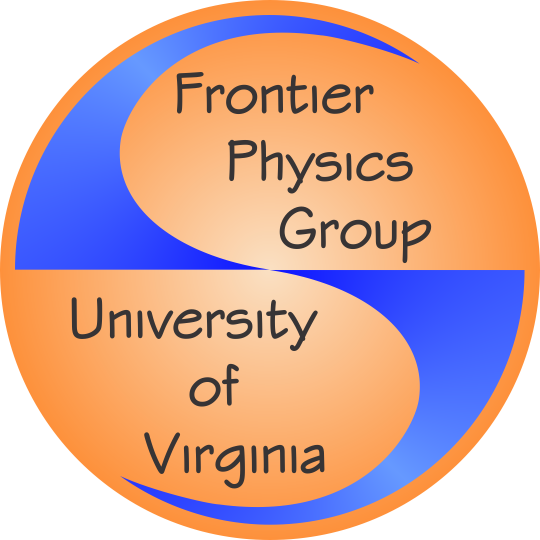Frontier Physics Group
At the University Virginia Physics Department
Charlottesville, Virginia, USA


![[IMG]](nova_logo.gif) NOvA Experiment
NOvA Experiment
In the twenty years since the discovery of neutrino mass through neutrino oscillations — the first evidence of physics beyond the standard model — much has been learned about neutrinos, although much remains yet to be learned. NOvA is a long-baseline neutrino oscillation experiment designed to search for electron-neutrino appearance in a muon-neutrino beam produced at Fermilab. It is making a variety of seminal measurements of neutrino properties, in particular a measurement of the neutrino mass hierarchy, the octant of the largest neutrino mixing angle, and whether CP is violated in the neutrino sector. NOvA is one of the flagship experiments of the Fermilab experimental program, indeed the US domestic particle physics program. It consists of two detectors, a far detector sited in northern Minnesota, and a near detector on-site at Fermilab. The far detector, at 14,000 tons, is one of the largest ever built. Construction started in 2009 and was completed in the summer of 2014. NOvA started publishing results in 2016. Our first three publications were all ``Editor's Suggestions'' in Physical Review Letters and Physical Review D. To date we have published over ten physics papers. NOvA will continued taking data untl well into this decade. Virginia's role on NOvAThe University of Virginia group has been working on NOvA since 2003. We have been intimately involved in the design, fabrication, and data analysis of the experiment. Our group designed and fabricated the Power Distribution System that provides power to all of the electronics. We also led the initial design of the Detector Controls and Monitoring Systems that essentially runs the detector and insures it is working properly. Two of each system were fabricated: one for the Near Detector and one for the Far Detector. We led the Block Instrumentation Group, which outfits the far detector with an array of sensors to enable its proper fabrication and to monitor its structural integrity. We led the Data-driven Trigger Group through its design and commissioning. Finally, the Virginia group also played an important role in the Data Acquisition Group, led by Dr. Andrew Norman (who left to take a permament position at Fermilab). Virginia's lead role in PDSThe NOvA Power Distribution System (PDS) provide all of the power to the 357,120 channels of electronics in the Far Detector, including 11,160 front-end boards, thermoelectric coolers, and avalanche photo-diodes, and 180 Data Concentrator Modules. Included in the system are 180 Power Distribution Boxes designed by the Virginia group, 60 low-voltage, high-current power supplies, 2 multi-channel high-voltage power supplies, 16 relay racks, 23.5 km of cables, and 3.5 km of cable trays. The physical size and unique topology of the NOvA detector, when combined with the power demands and cooling requirements of the front end electronics, make the PDS and electronics infrastructure design a formidable challenge which requires significant electrical and mechanical design and engineering. Virginia's lead role in DCSThe Virginia group is responsible for the Detector Controls and Monitoring (DCS) systems. Our group's expertise with data acquisition systems, combined with our experience in modern computing have allowed us to develop a robust platform capable of handing the continuous readout, buffering, and real time data processing that is required by the NOvA physics program. The DCS systems that Virginia is responsible for provide the full hardware/software interfaces and data readout for the experiment and are the fundamental window to for the physicist to control monitor the NOvA detectors.
|
|